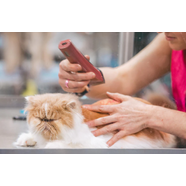How to clip your cat

Remember that not all cats tolerate grooming with clippers, so it's essential to be patient and gentle. If your cat is particularly anxious or resistant, you may want to consider seeking the help of a professional groomer or consulting with your veterinarian for advice. Additionally, regular brushing can help prevent matting and reduce the need for extensive clipping.
Here are some key points to keep in mind when choosing and using cat hair clippers:
Silent operation:
- Because cats might be sensitive to loud noises, search for clippers that operate softly to keep your cat calm when grooming.
Corded vs. cordless:
- Cordless clippers provide greater mobility, but they must be recharged. Corded clippers offer constant power but may limit your movement. Choose based on your preferences and your cat's comfort.
Options for Blades:
- Different blades are appropriate for different coat lengths. Some clippers have changeable blades, while others may require variable length blades. When selecting, keep your cat's coat type and prefered length in mind.
Material of the blade:
- Stainless steel blades are widespread and long-lasting, however they can become hot during usage. Ceramic blades are cooler yet more brittle.
Grooming Kit Specifications:
- Some cat clippers are included in grooming packages that also contain comb attachments, scissors, and other equipment. These kits might be useful for general grooming.
Safety features include:
- To help prevent unintentional wounds to your cat's skin, look for clippers with safety features like as rounded blade tips and guards.
Simple to clean:
- To ensure hygiene, clippers should be simple to clean. Some types feature removable blades for simple cleaning, while others may come with cleaning brushes or maintenance oil.
Life of the battery:
- Consider the battery life while purchasing cordless clippers. Longer battery life might be advantageous for grooming sessions, especially if your cat is not happy with prolonged grooming.
Grip and comfort:
- Consider the ergonomics of the clippers, making sure they are pleasant to handle during the grooming process. A non-slip grip might be beneficial.
Vibration and noise:
- Cats are susceptible to both noise and vibration. To lessen tension when grooming, choose clippers with little vibration and noise.
Desensitisation and training:
- Allow your cat to become accustomed to the sound and feel of the clippers by introducing them gradually. To develop favourable connections, pair the introduction with good experiences such as treats.









